A patchwork kitchen apron is made of geometric modules decorated with multi-colored ornaments. The design of this element in the interior is very important.
If you understand the variety of modern styles, choosing the best option is not difficult.
How to choose a tile style
To choose the best tile style, you need to be guided by the existing interior. For each fashionable direction, you can choose the appropriate appearance of the material:
- Vanguard. Unsymmetrical modules, painted in bright colors with well-defined contours.

Avant-garde can be made with your own hands
- Empire style. Light chic combined with brightness and display of impeccable taste. Juicy shades and small ornaments will do. The shape of the tiles is only square or diamond-shaped.

Empire style is royal, so patchwork should also be royal
- Antique. A combination of hieroglyphs or old letters will be ideal, which requires an exclusive approach. Also, a great option is a combination of any patterns, fancy shapes on fragments of tiles, made in sand shades.

ornate tiles that resemble Byzantine ornaments will help create an interesting effect
- African. Ambiguous stripes, curved lines, or simply patches of fruit. This style can be either very simple, or a mixture of the avant-garde of the 18-19th centuries with purely African motives.

African patchwork looks colorful
- Baroque. Neat designs in tones ranging from beige to dark brown.

Baroque features a variety of decor that looks rich
- Oriental. Romantic blue, gold colors mixed with the rest of the spectrum like an uneven triangular mosaic.
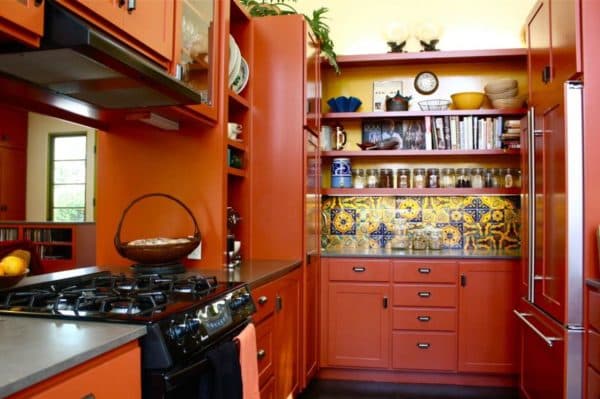
The oriental flavor of the cuisine is always warm and exotic, like spices
- Gothic. Austere lines in dark colors or direct attributes of a subculture. In the second case, exclusive modules will be required, on which the complete picture will be engraved with ornaments. Great style for creating a kitchen with a light top and dark bottom.
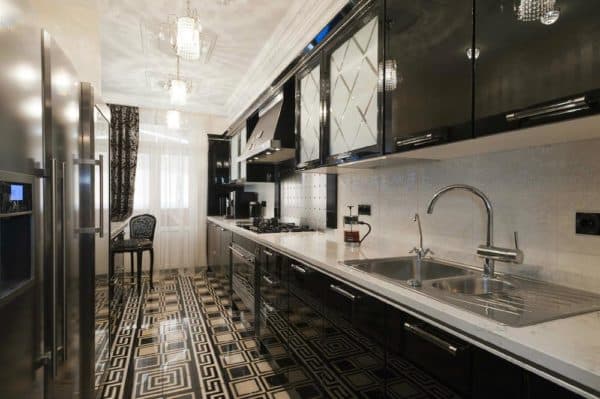
Gothic in the patchwork style is very restrained so as not to violate the overall severity
- Egyptian. The motives of the cultural heritage of this country look great. As an idea, you can take the outlines of pyramid blocks, make symmetrical drawings from them in spontaneous foreshortenings, painting each module in purely Egyptian colors: red, brown, sand.

The Egyptian style can also use patchwork elements that will mimic old drawings or papyrus letters.
- Country. Motives reflecting life in the village. If the whole kitchen is made in woody tones, you can dilute it with the help of kitchen panels – an apron with a base in pastel colors and drawing with a clear drawing of the contours.

Country – like a quilt made of different scraps
- Classicism. The tile can be of any shape, drawing, but you cannot add photographs, portraits and gloomy shades. Patchwork only emphasizes the main attributes of a classic interior, but is not a characteristic feature of it.

In the classic style, patchwork is rarely found, but its elements can be
- High tech. The differences in the motives are in the clear expression of the contours, the presence of any geometric shapes. The composition can be complex graphics intertwined with each other and painted in bright, juicy shades. An apron in this design can perfectly diversify the rather strict and laconic contours of the rest of the interior elements.

Hi-tech, oddly enough, can also use a patchwork apron
- Minimalism. This style often requires variety in order to exclude any gloomy notes. If the interior of the kitchen is represented by a minimum number of colors, then the apron can compensate for this feature with a bright ornament with a variety of combinations. When the interior is presented in bright and multifaceted colors, the apron, on the contrary, sets off this feature, avoiding clutter. In this case, you will need tiles in pure or even monochrome colors, equipped with a pattern with large ornaments.

To dilute boring minimalism, patchwork will help
Patchwork in the interior

The patchwork looks especially exquisite in the interior, made in a minimalist style. Any color solutions for the apron are appropriate if the rest of the areas are made in neutral colors: calm shades of gray, beige or white.
Patchwork designs on ceramic tiles or other material, laid out in fragments, will not only revive the design, but also reveal the impeccability of the taste of the kitchen owners.
There are many advantages to mixing a bright apron and a calm design of the rest of the room, made in pastel colors:
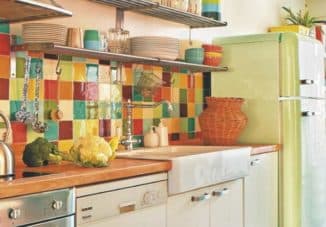
- Contrast.
- Freshness.
- Liveliness.
- Brightness.
- Creation of a ceremonial setting.
- The ability to make the design expressive.
- Similarity to the interiors presented by various fashion brands.
The patchwork apron looks exquisite, which repeats the color palette used in the rest of the kitchen interior.
It is necessary that it be distinguished by an ornament, have an unusual pattern, perhaps it even consisted of several stylistic directions, however, it was exactly similar in color, differed only in contrast.
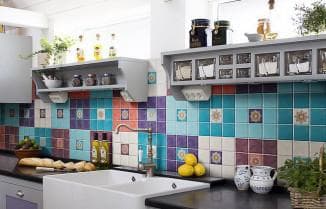
In order not to violate the harmony of the main palette, but at the same time to diversify the apron pattern, you can add neutral colors to the drawing, regardless of whether they are present in the rest of the interior or not. It is brown, silver, white, gray. In some cases, any pastel shades such as blue, green, pink, light purple will look spectacular, but not stand out. The most commonly used color to dilute the main subject is blue. It almost never spoils the overall look, but adds contrast to the ornament.
To give the kitchen a luxurious look, for example, following the Empire or Rococo style, it is necessary to purchase tiles with a noble glossy sheen.
These styles are distinguished by their colorfulness, richness of shades, so the patchwork will be appropriate not only in an apron for the kitchen, but also in other elements.
The more colorful and elegant details, the more natural the design looks. Noble styles symbolize wealth, high affluence and a glamorous life. To match them, you do not need to think too much about the colors of the patchwork. The drawing and the view from the side are important. If it matches the direction of the premium segment, then the correct option has been selected.
Ethno
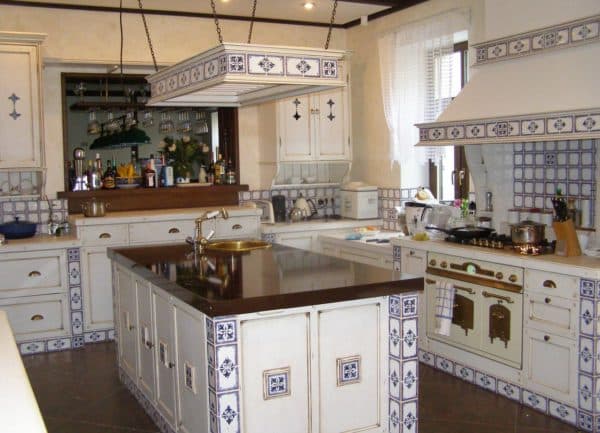
Ethno styles very often use patchwork style
Depending on the chosen direction (country, Moroccan, Russian, Chinese, Egyptian, Arabic), the patchwork ornament should reflect the culture of a particular people. Ethno is also an interracial style, so you can safely mix fashion trends taken from the culture of various ethnic groups.
Ethno style attracts people with its amazing harmony and at the same time mystery. People come home tired of work and stress, and the diverse, nostalgic style allows you to relax, feel cozy and calm.
An apron for the kitchen in this design direction will allow you to escape from everyday worries, gain a good mood, and think about pleasant moments even while cooking. This finishing element will look especially attractive if a fireplace is installed opposite.
Retro

Retro – perhaps we can’t imagine without patchwork
To use this style to create the design of the apron area, it is advisable to ensure that all other interior elements match it. Retro design features:
- The presence of furniture with smooth contours. All surfaces are polished.
- The decor cannot be monochromatic. Graphic and floral prints are a must, preferably with geometric motifs.
- The prevailing materials for furniture: wood, glass, plastic.
- Combination of pastel compositions with bright shades, a wide range of colors.
- Contrast of large and small items.
Even if not all of these aspects can be attributed to the design of a particular kitchen, creating a retro-style apron is not prohibited. It is desirable that the atmosphere be imbued with the spirit of the twenties. It’s great if the apron tile itself or the surrounding objects belong to the vintage style.
If an interior is chosen that reflects the direction of retro, then the patchwork may have blurry, sometimes not even clear colors. It becomes as if faded. Then the kitchen will be filled with the atmosphere of past years, will sparkle with colors of nostalgia.

To match the stylish direction of pop art, the color and shape of the apron modules should contain notes of retro-futurism. Plastic, mosaic, and ceramics are available for this style. The main features are bright colors and shiny, preferably glossy surfaces. The modules can reflect schematic flowers, the contours of the faces of celebrities of the twentieth century, drawn using a chaotic color palette, elements of graffiti. All this should be intertwined in a patterned pattern in the patterns inherent in the patchwork technique. You will find out how you can use mosaic tiles on an apron for the kitchen here.
How to transform ceramics

Here’s an option on how you can create a patchwork in the kitchen on your own.
- All work is carried out in rubber gloves. Before the restoration of the tiled coating, it is necessary to remove the dirt and, if possible, the damaged particles of the modules. To do this, you can use a stiff brush or spatula.
- The tile joints must be well cleaned, but they must not be chipped during operation. Do not use harsh tools to remove even tough deposits. All unnecessary substances can be softened using special solutions. They are carefully applied to contaminated elements, left for the time allotted in the instructions, and then washed off along with the softened dirt with plain water.
- If even a small amount of fungus is found on the seams or on the tile itself, the problem areas should be treated with a descaler. It is allowed to stand for about 10 minutes and then washed off with a cloth or soft sponge.
- If the tile joints are in standard white, the intensity and uniformity of the shade can be updated using a special white marker. Before using it, you need to shake it, and you should work with it by pressing the tip so that the flow of the substance is not excessive.
- For colored joints, joint paints have been developed. If you cannot find the right color, you can get it by mixing several shades. Coating is applied according to the instructions on the package. And you can find out about kitchens in green tones by following the link.
How to paint ceramics, watch the video master class:
After carrying out all the restoration work, it is necessary to wipe the clean surface with vinegar. It will help give the tiles a shine comparable to the appearance of a new product.
Restoration of deformed joints
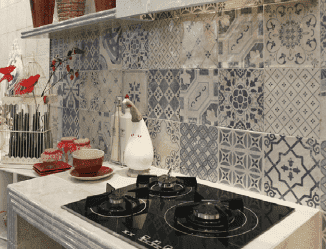
If chips form in the seams, it is necessary to eliminate the old grout with a spatula. If it is impossible to do this operation with a tool, you should use a special substance designed to dissolve cement compositions. It is applied to the seams with a brush and left on for a while. When the product works, all cement particles will be removed very quickly. After the elimination of the seams, the place allotted for them is washed with warm water with laundry soap dissolved in it and dried.

A thick layer of primer is applied to the seams. When this material is dry, fill the allotted space with new grout using a spatula. Excess material is removed fresh with a damp sponge. Do not carry out any work on the tiled surface until the grout dries. It is possible to renew the seams not along the entire length of the kitchen apron, but only in those places where their deformation is noticeable. You can find out how to decorate the walls in the kitchen here.
How to decorate tiles

Variant of the “marine” patchwork
To independently apply a patchwork pattern to a tile, you need to paint it. You can turn ordinary modules into designer ones not only after purchasing them, but even after a long service life. To achieve the maximum result, you should follow the algorithm of actions:

- The tiles are completely cleaned of dirt. If it has grease, streaks, it is necessary to use special products to ensure that the coating is perfectly smooth, favorable for applying paint. You can choose any universal detergent that can be used for cleaning ceramics. It is advisable to work with warm water to enhance the effect of the cleaning solution. If the tile is new, then you can limit yourself to washing it with laundry soap. The remaining tiles can be used to create a ceramic countertop.
- The protective layer is removed from the cleaned and dried tiles using fine-grained emery paper.
- An epoxy primer is applied to the surface in an even layer. Attention should be paid not only to the blocks themselves, but also to the seams connecting them.
- After processing, it is necessary to allow the surface to dry completely. Usually you have to take a break from work for 1 day.
- The tiles should be sanded to a completely smooth finish. If this operation is done incorrectly, it will be impossible to ensure high-quality adhesion of the paint to the epoxy primer.
- The primer and paint can be diluted in a small amount at first, and if it is not enough, then an additional portion can be made later. If you make a lot of mortar at once and do not use it for several hours, it will lose its basic properties and will not lay properly on the surface of the tile. It is necessary to withstand the solution no longer than indicated in the instructions.
- When choosing a paint, you should pay attention only to those options that are intended for application to a tiled surface.
- The paint is applied using a special roller to the location of the apron or to individual modules. Measured movements are made so that the coating is located as evenly as possible and is uniform. The first layer must be applied completely in a short period of time.
- Let the solution dry for about 12 hours.
- The second layer is applied immediately after the first has dried. The paint is mixed and spread over the substrate. In the process of work, you need to carefully check that an absolutely uniform coating is created. Modern paints allow you to make a perfectly even tone.
- The second layer is dried more thoroughly than the first, it will take up to three days.
- A multi-colored coating is applied using the patchwork technique. In advance, you should purchase all the necessary shades of paints, small brushes of different sizes. After choosing a suitable ornament, you can start painting the surface.
- It is not necessary to do all the work in one go. It is advisable to apply different colors alternately. First, complete the ornament in one shade, the next day with another, and so on until the complete formation of the conceived composition. This will help to avoid unnecessary mixing of colors, to create the clearest contours. And about the standard height of the apron in the kitchen, you can find out in this article.
Patchwork definitely deserves a place of the leader in the ability to embody any design ideas. Despite the multicolor nature, this technique, if properly designed, is applicable to any kitchen design. The disadvantages of patchwork include the laboriousness of selecting a suitable pattern, creating complex combinations of styles.
Also, it is not always possible to harmoniously choose color combinations with the interior. If the tiles for the apron are painted independently, the laboriousness and duration of the work is noted, however, when looking at the ideal result, all the negative aspects associated with the design process fade into the background. We also recommend that you familiarize yourself with the tiles for the kitchen of Kerama Marazzi in this material.

